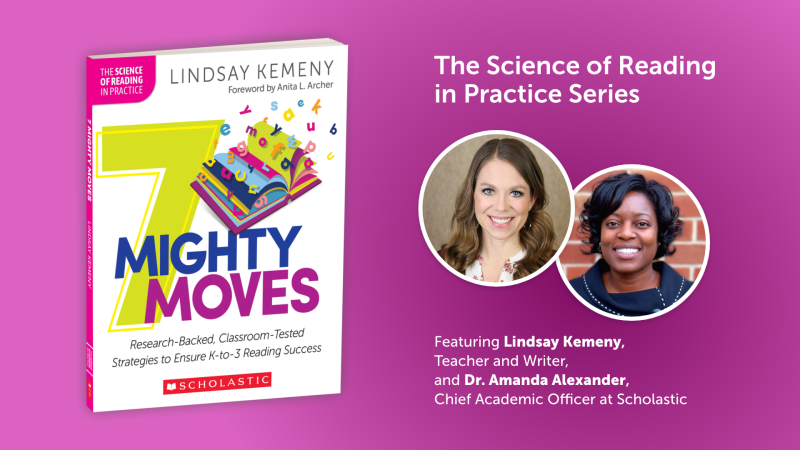Following the recent launch of Scholastic Educations' Literacy Framework, the team has kicked off a new six-part "Science of Reading in Practice" series to provide educators best practices for implementing evidence-based strategies into their reading instruction. Six Scholastic Professional Authors will share evidenced-based strategies rooted in classroom experiences that build the foundational skills students need to become successful, confident readers.
In our second webinar of the series, Lindsay Kemeny, author of 7 Mighty Moves, joined Dr. Amanda Alexander, Chief Academic Officer at Scholastic, to share a personal story about how she became passionate about childhood literacy, and seven overarching moves that K-3 teachers can implement to transform reading instruction.
1. Intentional phonemic awareness
- The National Reading Panel found that in kindergarten, about 18 hours of practice is optimal, which breaks down to about six minutes per day of oral-only phonemic awareness.
- Phonemic awareness is an awareness of the individual sounds in words, and it’s crucial that students practice blending, pulling apart, and segmenting sounds in order to learn to read, write, and spell.
- Teachers play a very important role in bringing phonemic awareness to phonics lessons, and can use interactives like puppets or bingo chips to help students visualizehow sounds connect with letters
2. Explicit and systematic phonics
- Teach high frequency spellings by starting with words that are less complex and slowly transitioning to more complex words.
- Make teaching interactive in order to elicit frequent responses from students. Whenthe opportunities to speak increase, learning goes up, and behavioral issues go down.
- Help students practice writing by incorporating dry erase boards so they can write out words and sentences – phonics time should be fun!
3. Three pointing prompts to decode words
- First, just point to the part of a word students missed and give them a second because sometimes they'll fix it themselves.
- Next, give a verbal prompt, like “what sound?"
- Finally, say the sounds aloud and blend them, allowing students to do the heavy lifting themselves without giving away the whole word.
4. Use decodable texts instead of predictable texts for beginning readers
- Remember that decodable texts are like training wheels – kids only need them for a short amount of time.The goal is to transition away from them as soon as they are ready.
- Instead of encouraging rote memorization through predictable, repetitive texts that spoon-feed students words, decodable texts are a great way to teach students how to sound out high frequency words, and better prepare them to read more rich texts with fewer decodable words.
5. Implement a better approach to sight words
- Students need to connect the sounds they hear with the letters on the page and the meaning of the word. Through a process called orthographic mapping, words are put into their memory for future retrieval.
6. Meaningful fluency practice
- When teaching an irregular high-frequency word, have students share the sounds in the word first, then write out the letters the sounds make to learn the spelling, noting if any of the spellings are particularly tricky to memorize for later.
- Think of sentences that include the word and share with your neighbor for more practice.
- Review by practicing spelling, reading, and writing high frequency words.
7. Build background knowledge and be intentional about vocabulary instruction
- Starting in kindergarten, one of the most important factors of good comprehension is how much vocabulary and background knowledge students have on the subject.
- Lindsay saw this move in practice with her son, who was fascinated by black holes. He devoured literature on the topic, and was able to read a book on the topic aloud to her as she struggled to understand the text.
- Even though Lindsay could decode better than her son, he had better comprehension because he understood all of the text since he had the background knowledge necessary.
For Lindsay’s son, who struggled with depression as a result of his dyslexia diagnosis, learning how to read using the above tips opened doors that helped bolster his self-esteem and mental health. This powerful experience for her as a mother and educator also allowed her to witness the power of literacy firsthand, sparking her passion to help other teachers give the gift of literacy to their students.
Check out the full webinar here and stay tuned for more tips and strategies from our “Science of Reading in Practice” webinar series! Be sure to follow @ScholasticEdu on X for more engaging educational content.
See all of Scholastic's Foundational Reading Skills resources.
Watch a short video about the Scholastic Literacy Framework.
ABOUT THE AUTHOR
Lindsay Kemeny has been teaching elementary school for 12 years and is currently teaching first grade. After her son was diagnosed with dyslexia and depression, she began her deep dive into effective literacy instruction. She is a CERI certified Structured Literacy Classroom Teacher and has a master’s degree in Curriculum and Instruction. In addition to being a classroom teacher, Lindsay enjoys presenting both locally and nationally, and loves being a co-host of the Literacy Talks Podcast. She has had articles published in The Reading League Journal, Dystinct Magazine and IDA Perspectives. She lives in northern Utah with her husband and four children. You can follow her on Twitter @LindsayKemeny.



